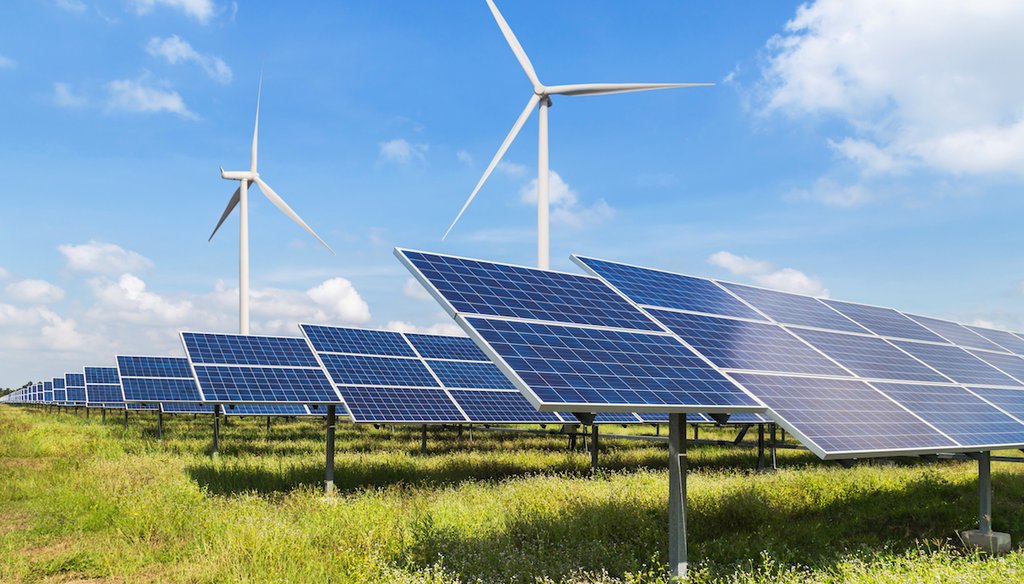



Wind and solar have expanded and produce about 10% of U.S. electricity. (Shutterstock)
New wind and solar utility scale operations will provide 70% of new electricity capacity in 2021.
Falling costs, tax credits and state renewable-energy goals are among the main drivers.
Wind and solar account for about 10% of total electricity generation, with about 60% coming from fossil fuels.
In his rollout of major actions on climate change, President Joe Biden laid out his 2035 goal to see an electricity sector that puts zero carbon into the air. Biden emphasized that the change is underway.
"Already, 84% of all new electric capacity planned to come onto the electric grid this year is clean energy," Biden said Jan. 27. "Why? Because it’s affordable; because it’s clean; because, in many cases, it’s cheaper."
The part about 84% of new electricity capacity being clean energy stood out, and we dug into it.
The latest government data backs him up.
According to the U.S. Energy Information Administration, the new electric capacity slated to come online in 2021, measured in total gigawatts, will be 39% solar, 31% wind, 11% from batteries, and 3% nuclear. That’s where Biden got his 84%.
Do those sources really amount to "clean" energy? There’s a separate debate over nuclear power, because while it’s carbon-free, there’s the long term problem of nuclear waste. But that aside, there’s also room to question the inclusion of battery power, as the federal government does.
"Batteries probably shouldn’t be in the total," said energy economist Kenneth Gillingham with Yale University. "They are not actually generating electricity. They are simply storing it for use at other times."
Gillingham underscored that the link between batteries and renewables is strong, because batteries are vital to building the market for solar and wind power. But today, he said, batteries could well be charged with fossil-fuel powered electricity.
Taking batteries out of the total, at least 70% of the new electric power capacity is carbon-free, which isn’t too far from what Biden said.
Still, while electricity from wind and solar has grown rapidly, it represents only about 10% of the national total. Fossil fuels power over 60% of the nation’s electricity supply.
A peek at the details of the latest government report shows a surge of new renewable power coming online in December 2021. The Solar Energy Industries Association, a trade group, said that’s a result of federal investment tax credits. Those credits let facility owners deduct a percentage of the project cost from their taxes. Until Congress changed the law at the end of 2020, that particular financial incentive was due to drop from 22% in 2021 to 10% in 2022. With millions of dollars in play, companies didn’t want to lose the 12-point difference and moved projects along as quickly as they could.
The experts we reached said several factors led the country to see less new capacity fueled by natural gas, and more by renewables. On top of the tax credits, technology improvements, state and local level policies to boost renewable power and demand from utilities and industry combined to make renewables the leading option.
The 2021 number is no outlier. There have been ups and downs, but over the past 10 years, renewables have averaged over 57% of new utility-scale electric capacity.
Susan Tierney, senior adviser with the private consulting firm Analysis Group in Denver, said Biden’s statistic shows progress on the climate change front, but it also underscores how much remains to be done.
"It is clear that there will need to be continued, and accelerated, additions of renewables, storage, and other zero-carbon technologies in upcoming years, in order to decarbonize the electric system," Tierney said. "The 84% increase is just one more year’s increment, and many multiples of that amount will be needed."
Biden said that 84% of new electric capacity scheduled to come online in 2021 was from clean energy.
The number is credible, but it includes 11% from battery storage. Batteries are essential to the expansion of wind and solar power, but they are not necessarily "clean" energy sources; they could be charged with electricity produced from fossil fuels.
Taking batteries out of the equation still leaves a total of about 70% from wind and solar. However, renewables remain a lesser slice of electricity supply. About 60% of the nation’s electric power comes from fossil fuels.
We rate this claim Mostly True.
White House, Remarks by President Biden Before Signing Executive Actions on Tackling Climate Change, Creating Jobs, and Restoring Scientific Integrity, Jan. 27, 2021
U.S. Energy Information Administration, What is U.S. electricity generation by energy source?, Nov. 2, 2020
U.S. Energy Information Administration, Renewables account for most new U.S. electricity generating capacity in 2021, Jan. 11, 2021
U.S. Energy Information Administration, Natural gas and renewables make up most of 2018 electric capacity additions, May 7, 2018
JDSupra Legal News, Stimulus Bill Brings Welcomed Changes to the Renewable Energy Industry, Jan. 8, 2021
International Institute for Sustainable Development, In 2018, 66% of New Electricity Generation Capacity was Renewable, Price of Batteries Dropped 35%, April 9, 2019
Pew Research, Renewable energy is growing fast in the U.S., but fossil fuels still dominate, Jan. 15, 2020
GreenTech Media, Almost All New US Power Plants Built in 2021 Will Be Carbon-Free, Jan. 14, 2021
Solar Energy Industries Association, Solar Investment Tax Credit, accessed Jan. 28, 2021
Email exchange, Kenneth Gillingham, associate professor of economics, Yale University, Jan. 28, 2021
Email exchange, Susan F. Tierney, senior advisor, Analysis Group, Jan. 28, 2021
In a world of wild talk and fake news, help us stand up for the facts.
